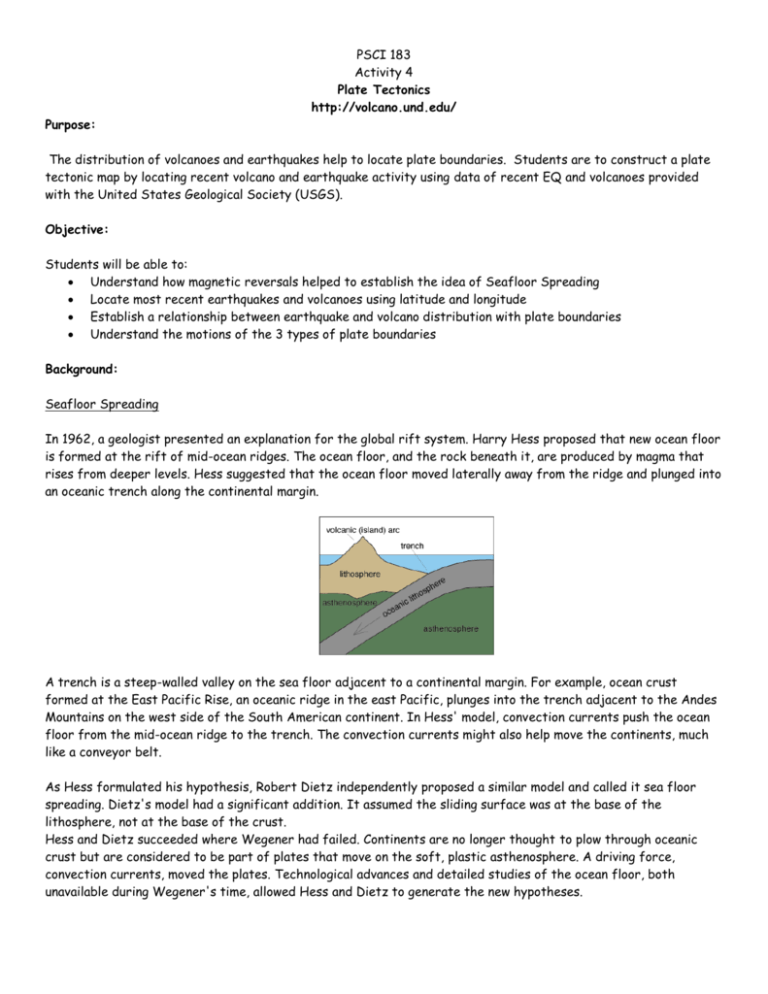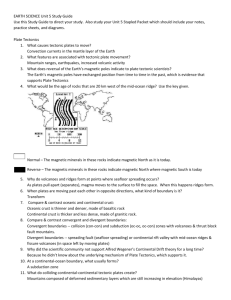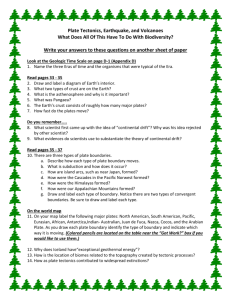psci183.act4.plate_tectonics.inf - Cal State LA
advertisement

PSCI 183 Activity 4 Plate Tectonics http://volcano.und.edu/ Purpose: The distribution of volcanoes and earthquakes help to locate plate boundaries. Students are to construct a plate tectonic map by locating recent volcano and earthquake activity using data of recent EQ and volcanoes provided with the United States Geological Society (USGS). Objective: Students will be able to: Understand how magnetic reversals helped to establish the idea of Seafloor Spreading Locate most recent earthquakes and volcanoes using latitude and longitude Establish a relationship between earthquake and volcano distribution with plate boundaries Understand the motions of the 3 types of plate boundaries Background: Seafloor Spreading In 1962, a geologist presented an explanation for the global rift system. Harry Hess proposed that new ocean floor is formed at the rift of mid-ocean ridges. The ocean floor, and the rock beneath it, are produced by magma that rises from deeper levels. Hess suggested that the ocean floor moved laterally away from the ridge and plunged into an oceanic trench along the continental margin. A trench is a steep-walled valley on the sea floor adjacent to a continental margin. For example, ocean crust formed at the East Pacific Rise, an oceanic ridge in the east Pacific, plunges into the trench adjacent to the Andes Mountains on the west side of the South American continent. In Hess' model, convection currents push the ocean floor from the mid-ocean ridge to the trench. The convection currents might also help move the continents, much like a conveyor belt. As Hess formulated his hypothesis, Robert Dietz independently proposed a similar model and called it sea floor spreading. Dietz's model had a significant addition. It assumed the sliding surface was at the base of the lithosphere, not at the base of the crust. Hess and Dietz succeeded where Wegener had failed. Continents are no longer thought to plow through oceanic crust but are considered to be part of plates that move on the soft, plastic asthenosphere. A driving force, convection currents, moved the plates. Technological advances and detailed studies of the ocean floor, both unavailable during Wegener's time, allowed Hess and Dietz to generate the new hypotheses. Testing the Seafloor Spreading Hypothesis Before being widely accepted, a new hypothesis must be tested. One test for the sea-floor-spreading hypothesis involved magnetic patterns on the sea floor. In the late 1950's, scientists mapped the present-day magnetic field generated by rocks on the floor of the Pacific Ocean. The volcanic rocks which make up the sea floor have magnetization because, as they cool, magnetic minerals within the rock align to the Earth's magnetic field. The intensity of the magnetic field they measured was very different from the intensity they had calculated. Thus, the scientists detected magnetic anomalies, or differences in the magnetic field from place to place. They found positive and negative magnetic anomalies. Positive magnetic anomalies are places where the magnetic field is stronger than expected. Positive magnetic anomalies are induced when the rock cools and solidifies with the Earth's north magnetic pole in the northern geographic hemisphere. The Earth's magnetic field is enhanced by the magnetic field of the rock. Negative magnetic anomalies are magnetic anomalies that are weaker than expected. Negative magnetic anomalies are induced when the rock cools and solidifies with the Earth's north magnetic pole in the southern geographic hemisphere. The resultant magnetic field is less than expected because the Earth's magnetic field is reduced by the magnetic field of the rock. When mapped, the anomalies produce a zebra-striped pattern of parallel positive and negative bands. The pattern was centered along, and symmetrical to, the mid-ocean ridge. A hypothesis was presented in 1963 by Fred Vine and Drummond Matthews to explain this pattern. They proposed that lava erupted at different times along the rift at the crest of the mid-ocean ridges preserved different magnetic anomalies. For example, lava erupted in the geologic past, when the north magnetic pole was in the northern hemisphere, preserved a positive magnetic anomaly. In contrast, lava erupted in the geologic past, when the north magnetic pole was in the southern hemisphere, preserved a negative magnetic anomaly. Lava erupting at the present time would preserve a positive magnetic anomaly because the Earth's north magnetic pole is in the northern hemisphere. Vine and Matthews proposed that lava erupted on the sea floor on both sides of the rift, solidified, and moved away before more lava was erupted. If the Earth's magnetic field had reversed (changed from one geographic pole to the other) between the two eruptions, the lava flows would preserve a set of parallel bands with different magnetic properties. The ability of Vine and Matthews' hypothesis to explain the observed pattern of ocean floor magnetic anomalies provided strong support for sea floor spreading. Subduction If new oceanic lithosphere is created at mid-ocean ridges, where does it go? Geologists had the answer to this question before Vine and Matthews presented their hypothesis. In 1935, K. Wadati, a Japanese seismologist, showed that earthquakes occurred at greater depths towards the interior of the Asian continent. Earthquakes beneath the Pacific Ocean occurred at shallow depths. Earthquakes beneath Siberia and China occurred at greater depths. After World War II, H. Benioff observed the same distribution of earthquakes but could not offer a plausible explanation. The movement of oceanic lithosphere away from mid-ocean ridges provides an explanation. Convection cells in the mantle help carry the lithosphere away from the ridge. The lithosphere arrives at the edge of a continent, where it is subducted or sinks into the asthenosphere. Thus, oceanic lithosphere is created at mid-ocean ridges and consumed at subduction zones, areas where the lithosphere sinks into the asthenosphere. Earthquakes are generated in the rigid plate as it is subducted into the mantle. The dip of the plate under the continent accounts for the distribution of the earthquakes. Magma generated along the top of the sinking slab rises to the surface to form stratovolcanoes. Birth of Plate Tectonics The new hypotheses of the early 1960s explained several puzzling sets of observations. All that remained was a synthesis of these hypotheses. The synthesis began in 1965 when Tuzo Wilson introduced the term plate for the broken pieces of the Earth's lithosphere. In 1967, Jason Morgan proposed that the Earth's surface consists of 12 rigid plates that move relative to each other. Two months later, Xavier Le Pichon published a synthesis showing the location and type of plate boundaries and their direction of movement. Since the mid-1960s, the plate tectonic model has been rigorously tested. Because the model has been successfully tested by numerous methods, it is now called the plate tectonic theory and is accepted by almost all geologists. Location of Plate Boundaries Earthquakes and volcanoes, evidence of unrest in the Earth, help locate the edges of plates. Earthquakes are distributed in narrow, linear belts that circle the Earth. Some of these belts have only shallow (0-20 miles; 0-35 km) earthquakes, like the mid-Atlantic and east Pacific ridges. In contrast, earthquakes in other belts, like western South America and south-central Asia, are at shallow, intermediate (20-45 miles; 30-70 km), and deep (45-450 miles; 70-700 km) levels. Volcanoes are also distributed in long belts that circle the Earth. A dramatic example is the line of volcanoes that circles most of the Pacific Ocean. This belt is known as the "Ring of Fire" because it is the site of frequent volcanic eruptions. The distribution of earthquakes and volcanoes coincides at most locations. The Ring of Fire is an excellent example. Geologists believe that areas of intense geologic activity, indicated by earthquakes, volcanoes, and/or mountain building, mark the boundaries between lithospheric plates. The distribution of earthquakes, volcanoes, and mountain ranges define 7 large plates and 20 smaller plates. The Nazca and Juan de Fuca Plates consist of only oceanic lithosphere. The Pacific Plate is mostly oceanic lithosphere only a small slice of continental lithosphere in southern California and Baja Mexico. Most of the other plates consist of both oceanic and continental lithosphere. Types of Plate Motions The ways that plates interact depend on their relative motion and whether oceanic or continental crust is at the edge of the lithospheric plate. Plates move away from, toward, or slide past each other. Geologists call these divergent, convergent, and transform plate boundaries. At a divergent plate boundary lithospheric plates move away from each other. The mid-Atlantic Ridge, a topographically high area near the middle of the Atlantic Ocean, is an example of a divergent plate boundary. At a convergent plate boundary, lithospheric plates move toward each other. The west margin of the South American continent, where the oceanic Nazca Plate is pushed toward and beneath the continental portion of the South American Plate, is an example of a convergent plate boundary. At a transform plate boundary, plates slide past each other. The San Andreas fault in California is an example of a transform plate boundary, where the Pacific Plate slides past the North American Plate.








